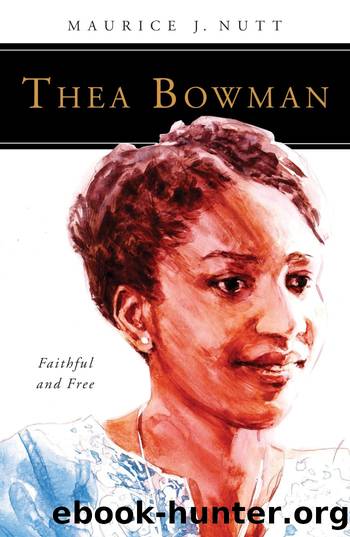Thea Bowman by Maurice J. Nutt

Author:Maurice J. Nutt
Language: eng
Format: epub
Publisher: Liturgical Press
Published: 2019-05-02T13:39:29+00:00
CHAPTER SIX
Returning to Her Roots, Race, and Old Time Religion (1978â1984)
African people became African Americans. Relating and communicating, teaching and learning, loving, and expressing faith in the God who loves and saves, they embodied and celebrated themselves and their values, goals, dreams, and relationships.1
Sister Thea Bowman, FSPA
It has been said that oneâs home is where oneâs mother and father live. In Theaâs case, then, home was still at 136 Hill Street in Canton, Mississippi, a place she first left when she was fifteen years old, but which now beckoned her back. Her mother, now nearly seventy-six years old, had been sick for some time. Her father was nearly eighty-four. It was clear that at his advanced age, he could no longer care for his wife by himself. When Dr. Bowman himself became ill, it was time for Thea to return to Canton. Theaâs devotion to her parents meant that anything else she was doing was secondary to their care. She moved into her childhood home to live with her parents once again. But even as Thea remained faithful to caring for her aging and infirmed parents, the demands for her preaching, teaching, sage wisdom, and leadership to an emerging black Catholic movement and consciousness were increasing.
Returning to Mississippi in 1978, she found that there were some advances in terms of race relations and yet there remained racial strife, segregation, intolerance, and a desperate need for racial reconciliation in the Magnolia State. She knew that she could not remain still or silent in the face of inequality and injustice.
The Roman Catholic Diocese of Jackson was being led at the time by Bishop Joseph Brunini, a native Mississippian whose father was Italian and mother was Jewish. He knew racial injustice first-hand and in those years just after the Second Vatican Council, he was not timid about pushing for change within both the church and society. Indeed, the New York Times had called him a ârisk-taking bishop.â2 Bishop Brunini courageously integrated the Catholic schools in Mississippi, to the fierce consternation of many white Catholics. He was a strong voice in addressing issues of ecumenism, evangelization, racism, poverty, and social justice. He assisted in establishing the interfaith Mississippi Religious Leadership Conference in 1970 and served as its first chairman.3 He was a fair and just man concerned about the needs of racial minorities, most especially black Catholics. Bishop William Houck succeeded Brunini as bishop of the Diocese of Jackson in 1984 and continued much of the work on racial justice he had begun. Both Brunini and Houck were friends and admirers of Thea. Likewise, she admired and respected their vision and leadership of the church in Mississippi. Recalling the hiring of Sister Thea to be director of the diocesan Office for Intercultural Awareness, Bishop Houck recalled in an interview, âI think it was Bishop Bruniniâs idea, that here was a wonderful black woman who was talented, who had her doctorate in English, a native daughter of Holy Child Jesus Parish. . . .
Download
This site does not store any files on its server. We only index and link to content provided by other sites. Please contact the content providers to delete copyright contents if any and email us, we'll remove relevant links or contents immediately.
Down the Drain by Julia Fox(924)
The Light We Carry by Michelle Obama(857)
Cher by Cher(718)
Simple Passion by Annie Ernaux(698)
Love, Pamela by Pamela Anderson(571)
Zen Under Fire by Marianne Elliott(537)
You're That Bitch by Bretman Rock(517)
The Foxfire Book of Appalachian Women by Kami Ahrens(499)
Novelist as a Vocation by Haruki Murakami(497)
Kamala Harris by Chidanand Rajghatta(473)
Alone Together: Sailing Solo to Hawaii and Beyond by Christian Williams(462)
The Nazis Knew My Name by Magda Hellinger & Maya Lee(441)
Gambling Man by Lionel Barber(436)
Drinking Games by Sarah Levy(397)
The Barn by Wright Thompson(389)
A Renaissance of Our Own by Rachel E. Cargle(385)
Memoirs of an Indian Woman by Shudha Mazumdar Geraldine Hancock Forbes(384)
Limitless by Mallory Weggemann(382)
A new method to evaluate the dose-effect relationship of a TCM formula Gegen Qinlian Decoction: âFocusâ mode of integrated biomarkers by unknow(363)
